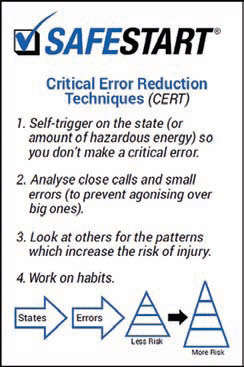Top priority
Larry Wilson doesn’t agree that human error is inevitable, any more than he believes that workplace injuries are just part of the job
But he argues that in order to prevent all injuries, everybody has to do more than follow procedures, they also have to stop making injury-causing errors. Simple, right?
Of course, it’s not so simple in reality because we are essentially talking about basic human nature. To err is human after all. But although some might argue that human error is eventually inevitable, there are ways to significantly reduce mistakes and critical errors that cause the vast majority of injuries if we attack the issue ‘head-on’.
In a high-risk industry such as construction, protecting workers and creating a safe environment requires companies to go beyond legal safety compliance and rules. They also need to start addressing the human factors that can lead to critical errors, which can lead to injury if the people are moving or things around them are moving. Even companies with high performing systems which can include behavioural safety observations (and other psychological approaches) have had very limited success at completely eliminating injuries like:
– slips and falls
– sprains and strains
– cuts, contusions and abrasions
– and back injuries
These four categories of injuries are typically the top four in every industry category (not including third world countries).
These types of injuries are difficult to prevent with conventional methods including behavioural safety because they don’t tackle human error head-on. Yes, behavioural safety observations do tackle deliberate risk, like someone not wearing a seat belt or a face shield, and they do create additional awareness or attention to safety, which indirectly helps to prevent mind on task errors, but it’s a byproduct. And how much attention or awareness is actually increased has a lot to do with how well the observations are actually done. So, the amount of that indirect benefit is dependent on the quality of the observations, and whether the observations actually have a meaningful feedback session or discussion included.
The direct approach: What causes people to make mistakes that increase the risk of injury?
Usually it’s states of mind or body like rushing, frustration, fatigue, complacency, panic, extreme joy or sorrow. However, extreme joy is not a big problem at most workplaces and although extreme sorrow and panic cause critical errors it’s not like we’re going to a funeral every day and (thankfully) were not running out of a burning building every day either. But unfortunately, not many days go by when we’re not in a rush, frustrated, tired or complacent. In fact, most days we can probably tick off all four states. What’s important though, is for people to realise that these states can cause common errors if they’re not moving, like not noticing an incorrect address on a shipping label, but that they can also cause critical errors and injuries if they are moving or things around them are moving.
Critical errors such as eyes not on task, mind not on task, being in or moving into the line of fire, or somehow losing your balance, traction or grip, can and do lead to injury. Over 95 per cent of all acute injuries, whether at work, on the road at home or in the community will have one or more of these critical errors are errors as contributing factors. Unfortunately, eliminating the four states from life or even work life just isn’t reality.
If the states are inevitable, how do we reduce or eliminate the errors?
Workers can be trained to recognise when they’re in one of the first three states and how to self-trigger on the state before a critical error happens. This is the first critical error reduction technique (see figure one CERT card).
Analysing close calls from a states and errors perspective, changing old habits and developing new (good) ones, and looking at others for state to error risk patterns are other techniquesthat enable workers to reduce the number of critical errors they make. It takes effort and time to build skills and create a new habit which means that the training has to provide that motivational component.
These techniques reduce errors, incidents and injuries at work, but they also become skills that your employees can use at home and on the road too. What’s more, they will also improve performance issues by reducing quality problems, unscheduled downtime or efficiency problems, and the needless equipment or vehicle damage that can also result from critical errors caused by the same four states.
From our experience, companies that are implementing a workplace process focusing on human error prevention and safety awareness are enjoying significant reductions in recordable injuries as well as fewer home injuries and vehicle incidents. However, training workers in a construction environment has many challenges. The training has to be efficient but flexible to accommodate the different trade groups and when they arrive on site. So, something that has a shorter front end but a longer back end in terms of toolbox talks or other ways to keep these concepts and techniques in mind is required.
When it is done well, workers (including construction workers) appreciate this kind of safety training, and it is common for them to take these concepts: states and errors, as well as the critical error reduction techniques, home to their families. In addition, they also feel more valued when they know that their safety and wellbeing 24/7 is genuinely a top priority for the company.
 Larry Wilson is the author of SafeStart, an advanced safety awareness training programme. The company is committed to improving employee engagement, culture and business results through critical error prevention training. SafeStart has worked with thousands of companies in over 60 countries help their workers to improve their situational awareness, become self-compliant, make better decisions and stay more alert to risk.
Larry Wilson is the author of SafeStart, an advanced safety awareness training programme. The company is committed to improving employee engagement, culture and business results through critical error prevention training. SafeStart has worked with thousands of companies in over 60 countries help their workers to improve their situational awareness, become self-compliant, make better decisions and stay more alert to risk.
For more information, please see www.safestart.com